Rose + Elderflower Cordial and a Perfumed Pan Polenta Cake from Terni
Gluten and Lactose-Free + With Strawberry Compote and Ricotta Cream
I first met polenta in the many-times-mentioned winter that I spent in Trento in my late 20s. There was an automatic shiny copper pot contraption thing slowly churning the soft corn on the stovetop of the turquoise Miele kitchen as the very old aunt of my ‘Italian sister’ recounted the details of her life during the war. I was fascinated, even if I did not understand a word she was saying. I was taken by her fleeting eyes, the movement of her hands, and the rising intonation of her voice. The next day, my pal sliced the then-cold polenta with a string and grilled it. A pungent melting mountain cheese was its companion.
We tend to associate polenta with the regional cooking of Northern Italy, but would you believe me if I told you that we have a strong historic polenta tradition here in Northeastern Lazio on the Rieti plain as part of a greater polenta culture that extends through the Apennines of Central Italy? True Story.
In the Northeastern corner of our Holy Valley, which paves a greenway to the borders of Umbria, we have a freshwater mill at Santa Susanna (Saint Susanna of Rome), which is powered by the clear icy green currents of fresh water that flow from the peaks of Mount Terminillo. This natural energy, which forms the base of our fresh water heritage, transforms walls of local corn crops into the ‘farina gialla’ or ‘farina di mais’, which also fuels the corn-based dishes of the cucina Sabina.
While the mill transforms the corn into flour or grain of various consistencies, the finer marigold finish known as ‘fioretto’ is the one preferred by locals to create soft velvety steaming pots of cooked polenta, which slowly expand like lava across rectangular wooden plates. The fioretto finish is also used for baking local bread, cakes and cookies.
The naturally gluten-free local polenta tradition was a delightful discovery when I first moved here as a celiac so many years ago, and many plates of polenta topped with various condimenti have been consumed since then. Later in the year, I plan to explore the story of Santa Susanna and our local polenta culture as a preface to our traditional recipes, but for now, I would like to focus on this adapted recipe for Pan Polenta, which comes from my mother-in-law’s recipe collection. I have always indulged in this cake thanks to her willingness to alter such recipes for my consumption.

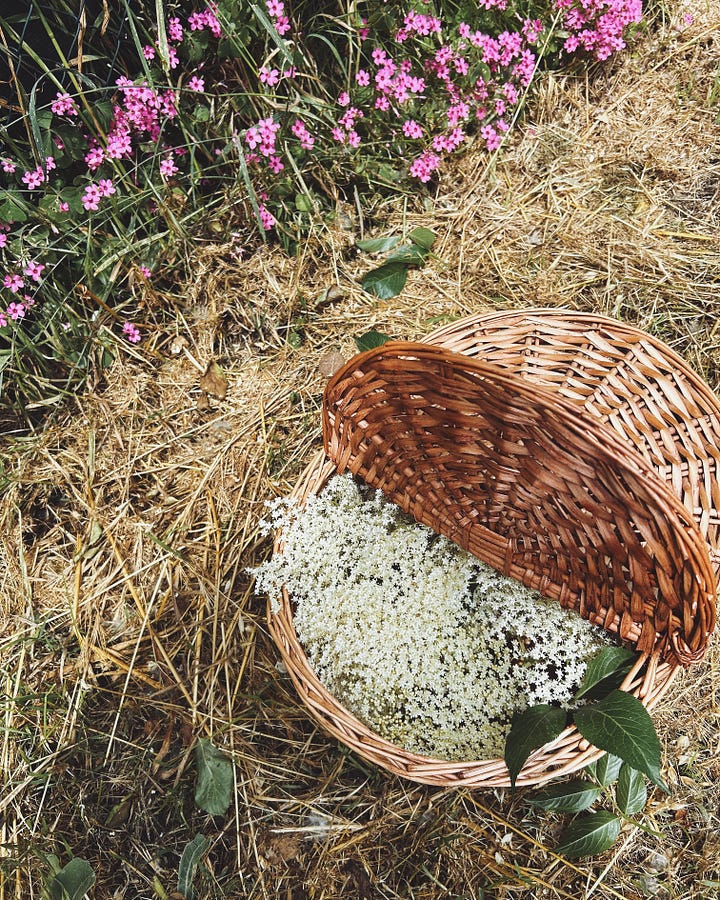
In May, it rained and rained and rained some more, which meant the green shades of the season’s flora (you probably understand by now that everything here is very green) were unusually pregnant and lush. This anomaly made for the wonderful elderflower season that is still going strong, and their presence permeates the air everywhere we go. What is always necessary this time of year to preserve their beauty and wonder is a cordial to perfume and flavour sparkling water, bubbly glasses of prosecco, fruit salads and desserts as the warmer months move ahead. This year, I was inspired to add some heady pink and red roses to my cordial with great results. Now, I cannot imagine that I will make it any other way.
Elderflower cordial is filed in my mind as an Irish thing, and so is the idea of splashing it into a cake.
Karn Healing, a wellness practitioner on the Dingle Peninsula, tells us what Elderflower means to the Irish in a recent post:
‘Light and ethereal, elderflower is nature’s gentle purifier. Traditionally used to reduce fevers, soothe colds, brighten the skin, and lower blood pressure. It’s also rich with folklore. In Irish and Celtic tradition, the elder tree (crann troim) was sacred — a guardian of the threshold between worlds. It was said that faeries and spirits made their homes within its branches. Gathering elderflower was a ritual of respect, women would often whisper a blessing or offering before taking its blooms. Elderflower carries the energy of protection, renewal, and joy.’
My mother-in-law’s autumn-inspired moreish Pan Polenta is laced with crushed walnuts from our tree and drunk with rum, nocino or brandy, so I decided to alter the ingredients to create a version that is more primaverile. I replaced the usual shot glass of alcohol with my elderflower and rose cordial simply because I thought it would be a good idea.
You also might be surprised to know that Irish food tradition holds corn-based recipes in its fold, but today, a stodgy, wet orange polenta cake always seems to be the gluten-free go-to in every Irish cafe. Fortunately, this one is different. Pan Polenta, also known as Amor Polenta, has a rustic and grainy finish that is delicate and soft at the same time. It is typically baked in a caterpillar-shaped pan, making for obvious portions to cut and serve to a crowd.
As mentioned, anything and everything associated with polenta is typically associated with the regions of the North, including Pan/Amor Polenta. Its ‘origins lie in the rural and agricultural context of Lombardy, where it is known as the dolce di Varese’. Apparently, Amor Polenta and this dolce di Varese are same same but different, and this interesting article tells us why.
Riccardo’s late zia Alberta, my mother-in-law’s sister, relocated to Varese in her youth to work at the Lindt factory, and you will find her influence scribbled across the pages of my mother-in-law’s recipe books. Zia Alberta, God rest her soul, possessed the trait of excessiveness, which is interlaced in the family’s DNA. Obsessed with cleanliness, she would stand over us as we enjoyed her always delicious saffron and sausage risotto, repeatedly asking us if we liked it and if we needed more Parmigiano. Zia Alberta reeked of generosity and love, gifting us the vintage wears that she blindly foraged from her cupboards as we departed.
My mother-in-law no longer remembers where she acquired her Pan Polenta recipe. It could have come from zia Alberta, and it also could have come from members of my father-in-law’s extended family who eventually found themselves building new lives in Terni, which lies twenty minutes north of our plain.
Like so many traditional recipes that exist in the modern state of Italian cuisine, Pan Polenta also has an identity in Terni. ‘Narni, Terni and Amelia in the province of Terni are the chosen lands of Pan Polenta, a delicate dessert typical of the Umbrian winter. ’ No doubt this is also inspired by regional corn cultivation and the local cucina povera.
‘The pastry of Terni is an important tradition that began in the early 1900s with a generation of pastry chefs who were able to develop both artisan and entrepreneurial skills…. Amor di pane brings the Ternana tradition of Pan Polenta and Panpepato as an ancient tradition of Central Italy’ — Daniela Zannetti, About Umbria Magazine
A few years ago, I acquired the low silver pans that have shaped my mother-in-law’s Pan Polenta for decades. Unfortunately, they are now showing spots of rust, so I was forced to search for a new one. Here in Italy, the traditional shops called casalinghi, typically carrying ‘Made in Italy’ homewares, have disappeared from Rieti in the last sixteen years (we had beautiful ones), unable to keep up with the competition from the shops selling cheap goods from China.
This phenomenon, not limited to Italy, breaks my heart to be honest, as these superstores, together with the horrific commercial centres being built on the outskirts of city centres, are degrading Italian cultural heritage. Irreparable damage has been caused to historic trading, artisan production and the economic health that shaped the unique character of these spaces. Towns which thrived for centuries are now in peril, hollowed out and struggling to survive.
New pans, the colour of silverfish, perfectly suited to the measurements of this recipe, can be found online, but I was delighted to find a suitable pan in my new favourite recently discovered casalinghi in Terni. This past winter, the older woman who runs the shop told me that it originally belonged to her mother and that she will keep it running for as long as she can. I love any excuse to grace its doors, always happy to acquire those certain artisan items that are not so easy to get your hands on these days. I was quite relieved when the Signora presented me with a pan large enough to suit recipes of various measurements.
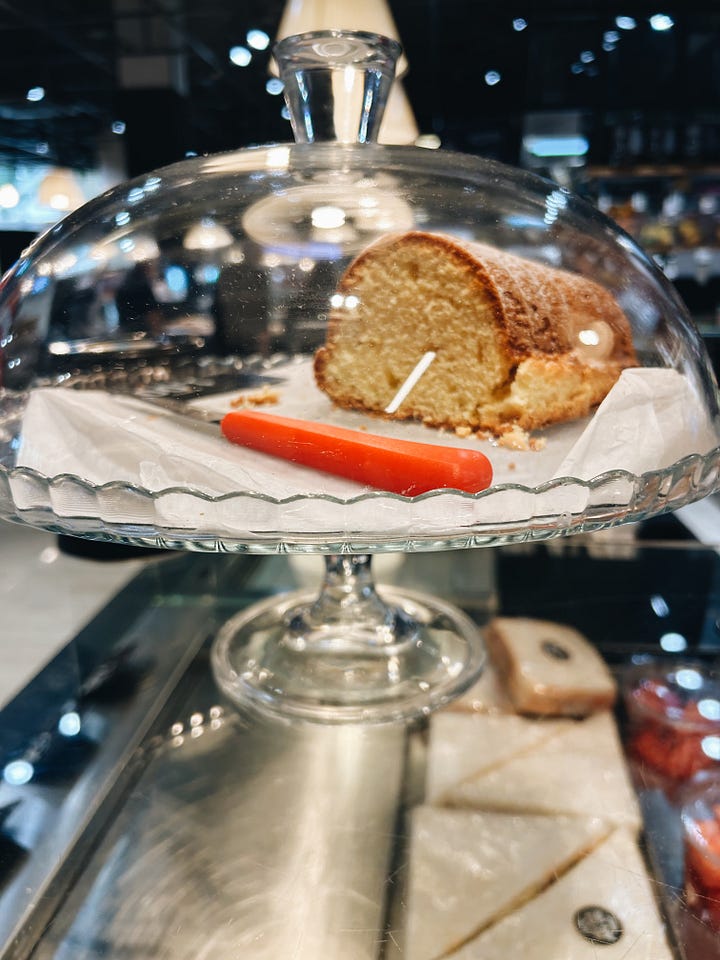
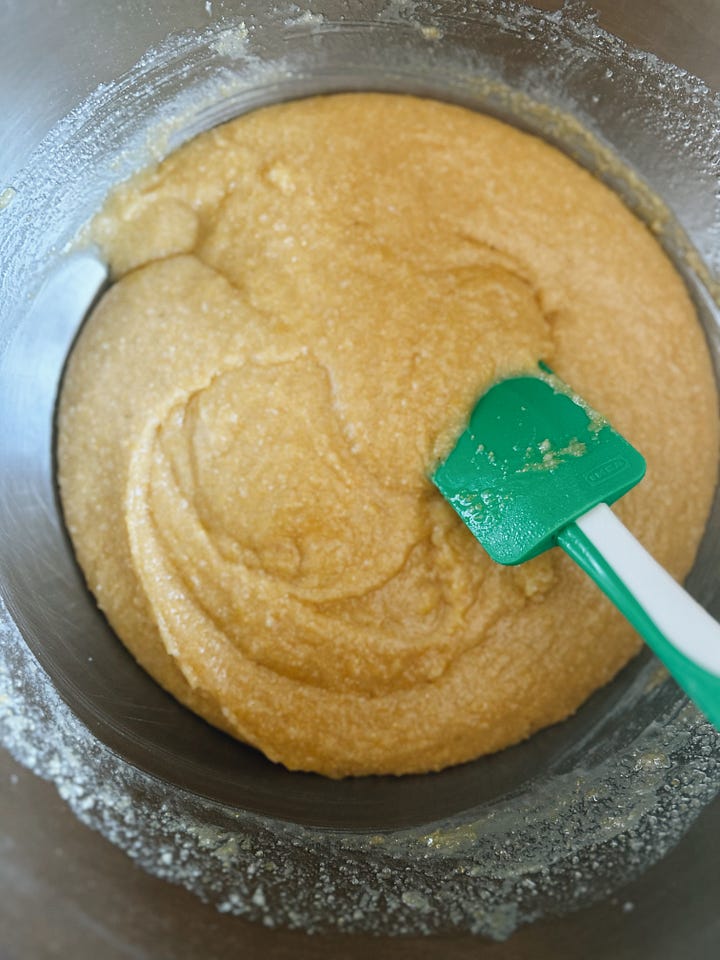
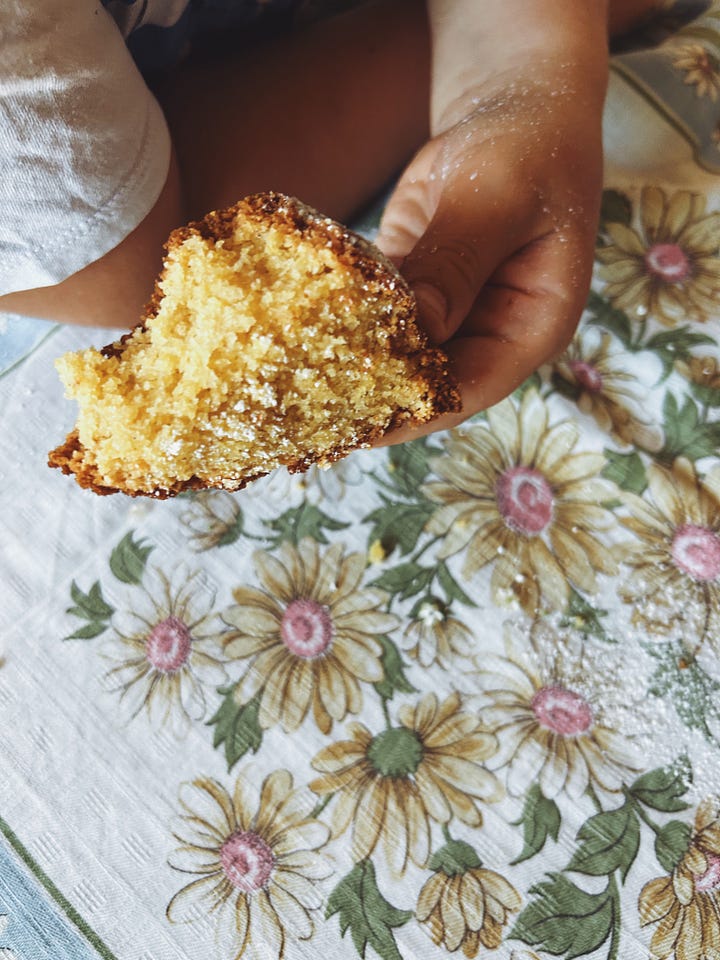

I prepared and baked this one-bowl recipe, made the strawberry compote and hand whipped the ricotta cream in the hour that I had before picking the kids up from school. Once I had them, I jumped out of the car to grab some fresh elderflower from the hedge, and we pulled the warm cake from the oven when we arrived home. The kids love to taste test and plate food for photos, and of course, their feedback is invaluable.
‘Hey, does this need more sugar?’
They attacked the Pan Polenta like rabid seagulls in the twenty minutes that we had before running out the door (to Terni) for practice, and we indulged in this combination again the next morning. It isn’t always easy to avoid buying things in packages, it seems impossible really, but recipes like this support that goal.
This flexible cake is wonderful on its own, but seasonal compotes of apricot, blueberry and cherry are also perfect here, together with your favourite cream or yoghurt, plated or served family style for breakfast, afternoon snack or evening dessert.
These are the recipes of rural heritage rooted in territory and the same intrinsic need for quick, hearty preparations to feed hungry mouths. We must continue to move these traditional recipes forward, thankful that some things never change.


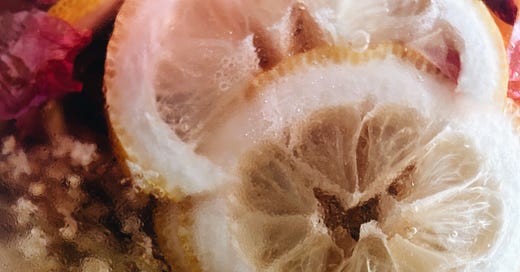



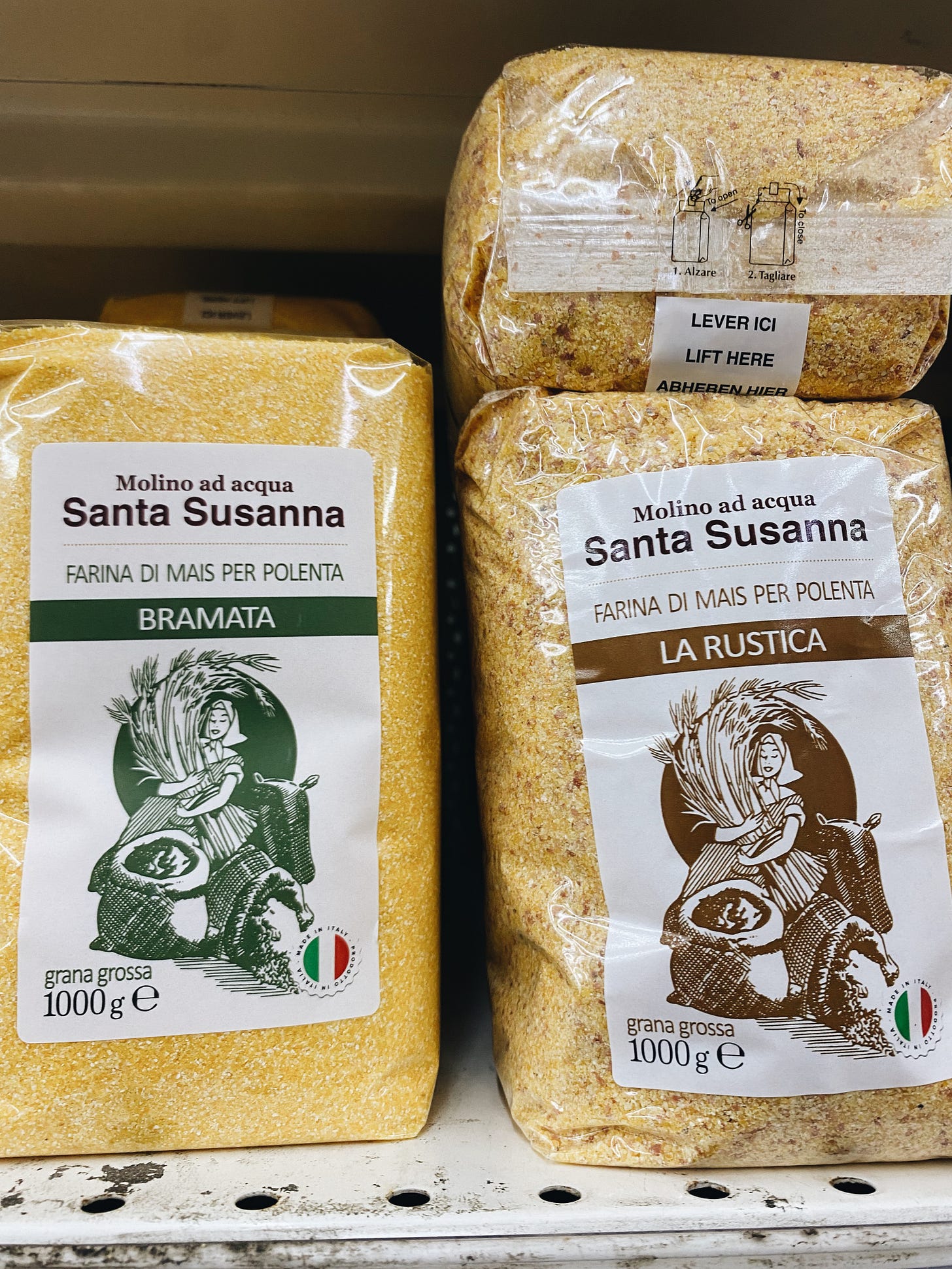

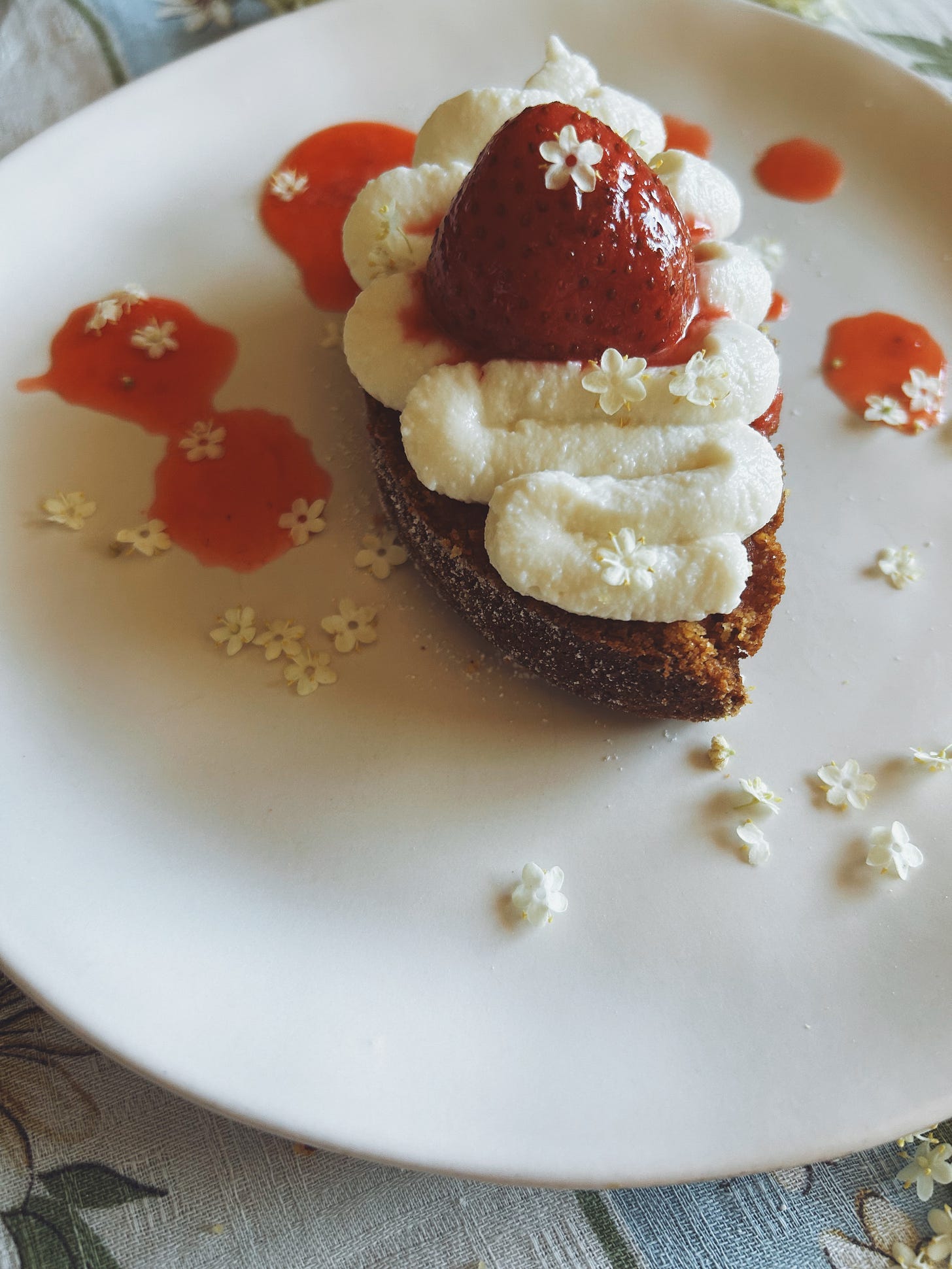




This is a lovely, generous piece - thanks for sharing
This looks delicious! Can you share the name/address of the casalinghi in Terni? We bought a little stone house in Narni last year, and we’re slowly moving there over the next few years. So far I’ve spent a lot of time at the local usato shops, but I’d love a source for traditional home wares.